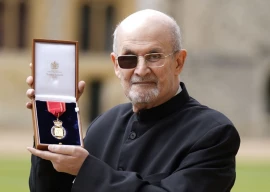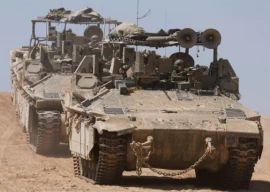
ISLAMABAD:
A one-day workshop on the dossier preparation for inscription of the Kalash Valley culture on the World Heritage List was organised at Lok Virsa on Wednesday.
The event was jointly organised by the National Institute of Folk and Traditional Heritage, the Ministry of National Heritage and Integration, and the Department of Archaeology and Museums.
In his opening remarks, chief guest and National Heritage and Integration Federal Secretary Faridullah Khan stated that the ministry is in the process of developing a plan for safeguarding endangered heritage property.
“This [dossier preparation] necessitates complete involvement from all stakeholders including local governments, NGOs, provincial and federal governments,” he stated.
The discussions revolved around certain measures to be taken for safeguarding Kalash cultural heritage including devising an inventory of endangered elements of tangible and intangible culture; efforts for documentation of Kalash culture; preserving Kalash culture in the villages of Bamborate, Birir and Rambur; safeguarding the language; preserving the music of Kalash in its original form; and protecting Kalash nomenclature currently under threat.
The word Kalash bears three meanings: name of the tribe, name of a pagan religion and it is also the name of an endangered language.
The present Kalash community is restricted to three parallel valleys of Chitral district ie Bomboret, Birir and Rambur called the Kalash valleys or Kafiristan. In the Birir and the Rambur valleys, the Kalash out number the non-Kalash while in the more picturesque Bamboret valley the non-Kalash are in a slight majority. These three narrow V-shaped valleys are situated in the south-west part of Chitral, Khyber-Pakhtunkhwa.
Historically, Kalash were majority population in Chitral and ruled it in the 12th century. In 1320, Muslim invader Rais conquered Chitral, and forcibly converted the Kalash community. After embracing Islam the Kalash community abandoned their religion as well as their language and ethnic identity, except a few thousand people who took refuge in three confined valleys of Bamboret, Birir and Rambur.
The Kalash population has significantly declined in the past 60 years. From 10,000 in 1951, the population fell to 3,700 in 2011.
Lok Virsa Executive Director Khalid Javaid stated that Lok Virsa has established a 3-D diorama at the National Heritage Museum to present the Kalash culture.
Published in The Express Tribune, March 1st, 2012.
COMMENTS (2)
Comments are moderated and generally will be posted if they are on-topic and not abusive.
For more information, please see our Comments FAQ













































Would you force another into your culture simply because YOU think it is more evolved? Improvement is all a matter of perspective after all.
i dont get this love affair with saving old cultures. What does that mean?
Does it mean to steal the right to evolve and improvment in quality of life?